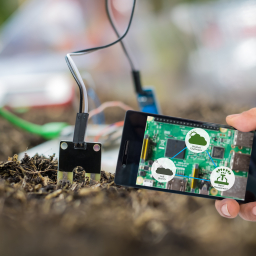NEW
A new generation of microscope for studying life hiding under the ground
21 January 2022A new generation of microscope for studying life hiding under the ground
- The new microscope, developed by an international consortium led by NEIKER, makes it possible to capture the movement of the microbes in the soil around the roots of growing plants for the first time
- This discovery will improve understanding of the interaction between plant roots and the microbes present in the soil, essential for more sustainable agricultural production
- “This development will have many applications such as the design of new strategies to improve crop fertilisation”, explains Lionel Dupuy, the principal researcher on the project
According to the Food and Agriculture Organisation (FAO) of the United Nations, by 2050 agricultural production must increase by around 50% to be able to meet the food demands of the world population as a whole, thus guaranteeing food safety. One of the main limitations in achieving this objective lies in the deterioration of soil quality, a natural resource that is non-renewable on a human time scale, with key functions such as food production and the maintenance of biodiversity. To be able to guarantee its conservation, it is essential to protect it and study it in a way that is respectful of the environment and as non-invasive as possible.
To date, the scientific studies centred on researching soil processes are especially complex due, on one hand, to the natural opacity of this ecosystem and, on the other, the fact that the current methods of study are generally invasive and do not allow biological activity to be seen as it happens.
In response to this problem, an international team of scientists led by NEIKER, member of the Basque Research and Technology Alliance (BRTA), has developed a new microscope that has made it possible to capture for the first time the movement of the microbes present in the rhizosphere -the layer of soil near the roots- and their interaction with the plant roots experiencing growth, in the moment and non-invasively.
This new research, which was recently published in the prestigious journal Proceedings of the National Academy of Sciences of the United States of America, seeks to improve understanding of the biological processes of the soil. Specifically, it will be possible to design new biological fertilisers, and improve crop irrigation regimes, to progress toward more sustainable agriculture in the fight to mitigate the effects of climate change.
This new development complements research completed in 2012 that developed an artificial transparent model of the earth, created in the laboratory, that reproduced the chemistry of natural soil, enabling plants to grow and facilitating direct observation of the behaviour of their roots.
As Ikerbasque researcher at NEIKER and project leader Lionel Dupuy explains, “plants have been grown in these transparent artificial soils that are custom made so that sensitive cameras can capture the activity of the microbes in the soil, live and at high resolution”. This has been possible thanks to the use of specialised lasers, optics and robotic scenarios of the latest generation. In this regard, the new microscope makes it possible to scan living samples and reconstruct three-dimensional maps of the activity of the microbes.
Window to more sustainable agriculture
Currently, the volume of soil explored by the microscope is only a few cubic centimetres, so only plants in their early stages of development are studied. Nevertheless, the work that is under way within the framework of this investigation will make it possible to examine broader panels with more mature plants, which, according to Dupuy, “will open up new horizons in research into the production of crops that best interact with the microbes in the soil, and their adaptation to irrigation and fertilisation more sustainable regimes, among other applications”.
Knowing how bacteria colonises plant roots is essential for developing biological fertilisers where the beneficial microbes can be kept within the surroundings of the root more easily. In this regard, these new biofertilisers will replace synthetic chemical products with live microorganisms that promote plant growth through the increased supply of nutrients for the host plant and the production of phytohormones.
In addition, the new microscope can also be used to optimise the composition of soil fertiliser.
To date, the role that the roots may play in improving the fertilisation of crops has not been studied enough. Nevertheless, “this must change if we want to adapt agriculture to climate change. The finding opens up a new window in this direction, a chance to be able to research the design of new strategies that can improve crop fertilisation in a more environmentally-friendly way, thus favouring more sustainable crop production”, highlights the NEIKER researcher.
This research was funded by the European Union through the Horizon 2020 research and innovation programme (Grant 647857 Agreement-SENSOILS) with the collaboration of The University of Dundee, The James Hutton Institute, Scotland’s Rural College and The University of Sheffield (United Kingdom), the Institut Charles Gerhardt Montpellier (France), as well as the Basque Foundation for Science, Ikerbasque and the NEIKER technology centre.






